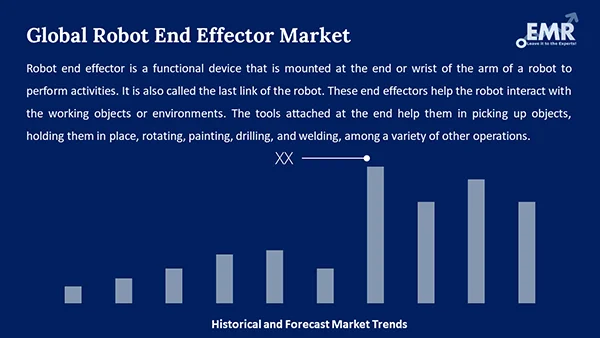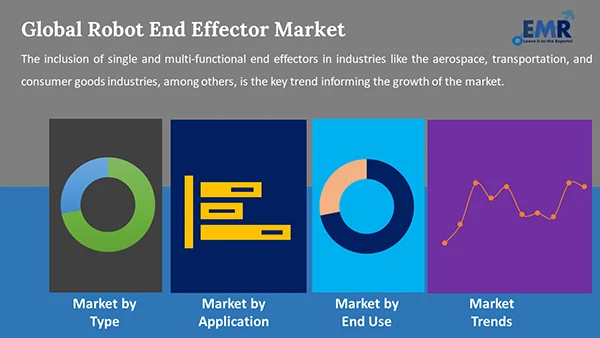
Consumer Insights
Uncover trends and behaviors shaping consumer choices today
Procurement Insights
Optimize your sourcing strategy with key market data
Industry Stats
Stay ahead with the latest trends and market analysis.
Trending Now



The global robot end effector market attained a value of nearly USD 4.3 billion in 2024. The market is further expected to grow at a CAGR of 15% during the forecast period of 2025-2034 to reach a value of USD 15.04 billion by 2034.
Base Year
Historical Year
Forecast Year






| Global Robot End Effector Market Report Summary | Description | Value |
| Base Year | USD Billion | 2023 |
| Historical Period | USD Billion | 2018-2024 |
| Forecast Period | USD Billion | 2025-2034 |
| Market Size 2024 | USD Billion | 4.3 |
| Market Size 2034 | USD Billion | 15.04 |
| CAGR 2018-2024 | Percentage | XX% |
| CAGR 2025-2034 | Percentage | 15% |
| CAGR 2025-2034 - Market by Region | Asia Pacific | 18.8% |
| CAGR 2025-2034 - Market by Country | India | 19.7% |
| CAGR 2025-2034 - Market by Country | Canada | 17.5% |
| CAGR 2025-2034 - Market by Type | Tool Changers | 17.1% |
| CAGR 2025-2034 - Market by Application | Welding | 17.3% |

Read more about this report - REQUEST FREE SAMPLE COPY IN PDF
The robot end effector is a functional device that is mounted at the end or wrist of the arm of a robot to perform activities. It is also called the last link of the robot. These end effectors help the robot interact with the working objects or environments.
The robot end effector market trends and dynamics are being driven by the tools attached at the end, which assist robots in tasks such as picking up objects, securing them, rotating, painting, drilling, and welding, among other functions.
The increased automation and the growing adoption of artificial intelligence (AI) across the globe are increasing the robotic density across sectors, which has been propelling the demand for robot end effector market. China, especially, has emerged as a major market for robot end effectors. China, with its Made in China Plan, is set to become a manufacturing hub and is expected to subsequently use automation for the same, making it a lucrative market for end effectors.
The region is projected to grow at a robust pace as compared to the more developed markets like North America and Europe. South Korea and Singapore are expected to play a major role in market growth, as both countries heavily utilise robots in their manufacturing processes, further accelerating the growth of the robot end effector industry.
China has adopted several strategic initiatives to enhance its robotics industry, including the 14th 5-Year Strategy Plan 2021, the Key Special Program on Intelligent Robots in 2022, and the Robotics+ Application Action Plan 2023. With a significant investment of USD 43.5 million in 2022, these efforts target a variety of sectors such as manufacturing, agriculture, architecture, logistics, energy, healthcare, education, elderly services, commercial community service, and emergency and extreme environment applications.
Germany's initiatives to advance robotics and technology include AUTONOMIK (2009-2014) for R&D in manufacturing and logistics, the PAiCE Program for robotics platforms in services and logistics, and the High-Tech Strategy 2025 to enhance human-technology interaction. With USD 345.6 million allocated for 2021-2026, the investment covers sectors such as health, services, chemicals, Industry 4.0, infrastructure, agrifood, and mobility & autonomous vehicles. This broad focus on technological advancement is expected to boost robot end effector industry revenue, as enhanced end effector designs help lower operational costs by reducing errors, cutting manual labour, and streamlining workflows.
According to World Robotics, the global number of industrial robot installations increased from 391,000 units in 2019 to 517,000 units in 2021. This rise of 126,000 units translates to a growth rate of approximately 32.2%, demonstrating significant expansion in the adoption of industrial robots over this period. From 2019 to 2021, the global operational stock of industrial robots saw a substantial increase. The number of units rose from 2,740,000 in 2019 to 3,477,000 in 2021. The increase of 737,000 units, representing a significant rise of about 26.9%, highlights the swift global expansion of industrial robots, according to World Robotics. This growth drives robot end effector market revenue, as high-quality end effectors improve robot accuracy in complex tasks, leading to higher production rates and fewer errors.
As per the International Federation of Robotics, in 2021, the annual installations of industrial robots saw significant growth across all regions. Asia/Australia led with 381,000 units, up from 284,000 units in 2018, marking a 38% increase. Europe installed 84,000 units, an increase from 76,000 units in 2018, reflecting a 24% growth. This substantial growth highlights the rising global adoption of industrial robots, boosting the robot end effectors demand growth as advanced end effectors enable these robots to perform a variety of tasks such as gripping, handling, assembly, and welding.

Read more about this report - REQUEST FREE SAMPLE COPY IN PDF
“Global Robot End Effector Market Report and Forecast 2025-2034” offers a detailed analysis of the market based on the following segments:
Market Breakup by Type
Market Breakup by Application
Market Breakup by End Use
Market Breakup by Region
| CAGR 2025-2034 - Market by | Country |
| India | 19.7% |
| Canada | 17.5% |
| China | 16.5% |
| USA | 15.1% |
| Australia | 12.8% |
| Japan | 11.2% |
| UK | XX% |
| Germany | XX% |
| France | XX% |
| Italy | XX% |
| Saudi Arabia | XX% |
| Brazil | XX% |
| Mexico | XX% |
Industries such as aerospace, transportation, life sciences, and consumer goods all utilize robotics for various tasks like warehousing, assembly, movement, gripping, and cutting. Even in consumer goods advertising, technical machines are required to manoeuvre, shift, or rotate materials to achieve optimal shots. Consequently, automation is driving increased demand for robot end effectors and is anticipated to continue supporting the growth of the robot end effector industry.
The companies offer advanced automation solutions like rotary actuators, custom end effectors, and tool changers, known for their innovative designs and high-quality products that enhance robotic efficiency and flexibility in manufacturing.
| REPORT FEATURES | DETAILS |
| Base Year | 2023 |
| Historical Period | 2018-2024 |
| Forecast Period | 2025-2034 |
| Scope of the Report |
Historical and Forecast Trends, Industry Drivers and Constraints, Historical and Forecast Market Analysis by Segment:
|
| Breakup by Type |
|
| Breakup by Application |
|
| Breakup by End Use |
|
| Breakup by Region |
|
| Market Dynamics |
|
| Competitive Landscape |
|
| Companies Covered |
|
| Report Price and Purchase Option | Explore our purchase options that are best suited to your resources and industry needs. |
| Delivery Format | Delivered as an attached PDF and Excel through email, with an option of receiving an editable PPT, according to the purchase option. |
Robot End Effector Market Size
Robot End Effector Market Growth
Robot End Effector Market Analysis
*While we strive to always give you current and accurate information, the numbers depicted on the website are indicative and may differ from the actual numbers in the main report. At Expert Market Research, we aim to bring you the latest insights and trends in the market. Using our analyses and forecasts, stakeholders can understand the market dynamics, navigate challenges, and capitalize on opportunities to make data-driven strategic decisions.*
Get in touch with us for a customized solution tailored to your unique requirements and save upto 35%!
The global robot end effector market value is assessed to grow at a CAGR of 15% between 2025 and 2034.
The market is estimated to witness robust growth in the forecast period of 2025-2034 to reach nearly USD 15.04 billion by 2034.
The increasing adoption of artificial intelligence and automation and surging manufacturing capabilities in the emerging economies are the major market drivers.
The key trends propelling the market include the growing inclusion of single and multi-functional end effectors in diverse end-use sectors and the rising use of automated machines in various applications.
The market is broken down into North America, Europe, Asia Pacific, Latin America, the Middle East, and Africa.
The leading types of robot end effectors in the market are grippers, clamps, suction cups, welding torches/guns, and tool changers, among others.
The significant applications of robot end effectors are handling, assembly, welding, dispensing, and processing, among others.
The various end uses of the product are automotive, food and beverage, pharmaceutical, e-commerce, metals, and machinery, and electrical and electronics, among others.
The competitive landscape consists of ABB Group, SCHUNK GmbH & Co. KG, KUKA AG, EMI Corporation, and ATI Industrial Automation, Inc., among others.
In 2024, the market reached an approximate value of USD 4.3 billion.
Datasheet
One User
USD 2,499
USD 2,249
tax inclusive*
Single User License
One User
USD 3,999
USD 3,599
tax inclusive*
Five User License
Five User
USD 4,999
USD 4,249
tax inclusive*
Corporate License
Unlimited Users
USD 5,999
USD 5,099
tax inclusive*
*Please note that the prices mentioned below are starting prices for each bundle type. Kindly contact our team for further details.*
Flash Bundle
Small Business Bundle
Growth Bundle
Enterprise Bundle
*Please note that the prices mentioned below are starting prices for each bundle type. Kindly contact our team for further details.*
Flash Bundle
Number of Reports: 3
20%
tax inclusive*
Small Business Bundle
Number of Reports: 5
25%
tax inclusive*
Growth Bundle
Number of Reports: 8
30%
tax inclusive*
Enterprise Bundle
Number of Reports: 10
35%
tax inclusive*
How To Order
Our step-by-step guide will help you select, purchase, and access your reports swiftly, ensuring you get the information that drives your decisions, right when you need it.

Select License Type
Choose the right license for your needs and access rights.

Click on ‘Buy Now’
Add the report to your cart with one click and proceed to register.

Select Mode of Payment
Choose a payment option for a secure checkout. You will be redirected accordingly.
Gain insights to stay ahead and seize opportunities.

Get insights & trends for a competitive edge.

Track prices with detailed trend reports.

Analyse trade data for supply chain insights.

Leverage cost reports for smart savings

Enhance supply chain with partnerships.

Connect For More Information
Our expert team of analysts will offer full support and resolve any queries regarding the report, before and after the purchase.
Our expert team of analysts will offer full support and resolve any queries regarding the report, before and after the purchase.
We employ meticulous research methods, blending advanced analytics and expert insights to deliver accurate, actionable industry intelligence, staying ahead of competitors.
Our skilled analysts offer unparalleled competitive advantage with detailed insights on current and emerging markets, ensuring your strategic edge.
We offer an in-depth yet simplified presentation of industry insights and analysis to meet your specific requirements effectively.



Australia
63 Fiona Drive, Tamworth, NSW
+61-448-061-727
India
C130 Sector 2 Noida, Uttar Pradesh 201301
+91-723-689-1189
Philippines
40th Floor, PBCom Tower, 6795 Ayala Avenue Cor V.A Rufino St. Makati City,1226.
+63-287-899-028, +63-967-048-3306
United Kingdom
6 Gardner Place, Becketts Close, Feltham TW14 0BX, Greater London
+44-753-713-2163
United States
30 North Gould Street, Sheridan, WY 82801
+1-415-325-5166
Vietnam
193/26/4 St.no.6, Ward Binh Hung Hoa, Binh Tan District, Ho Chi Minh City
+84-865-399-124
United States (Head Office)
30 North Gould Street, Sheridan, WY 82801
+1-415-325-5166
Australia
63 Fiona Drive, Tamworth, NSW
+61-448-061-727
India
C130 Sector 2 Noida, Uttar Pradesh 201301
+91-723-689-1189
Philippines
40th Floor, PBCom Tower, 6795 Ayala Avenue Cor V.A Rufino St. Makati City, 1226.
+63-287-899-028, +63-967-048-3306
United Kingdom
6 Gardner Place, Becketts Close, Feltham TW14 0BX, Greater London
+44-753-713-2163
Vietnam
193/26/4 St.no.6, Ward Binh Hung Hoa, Binh Tan District, Ho Chi Minh City
+84-865-399-124
Share